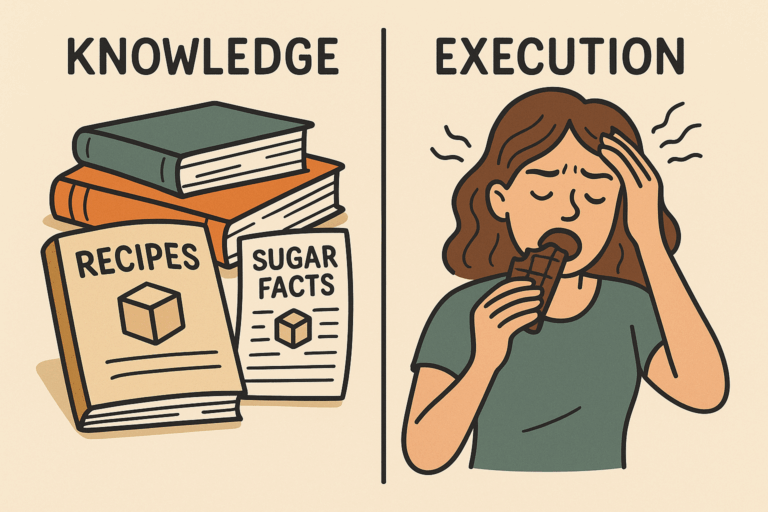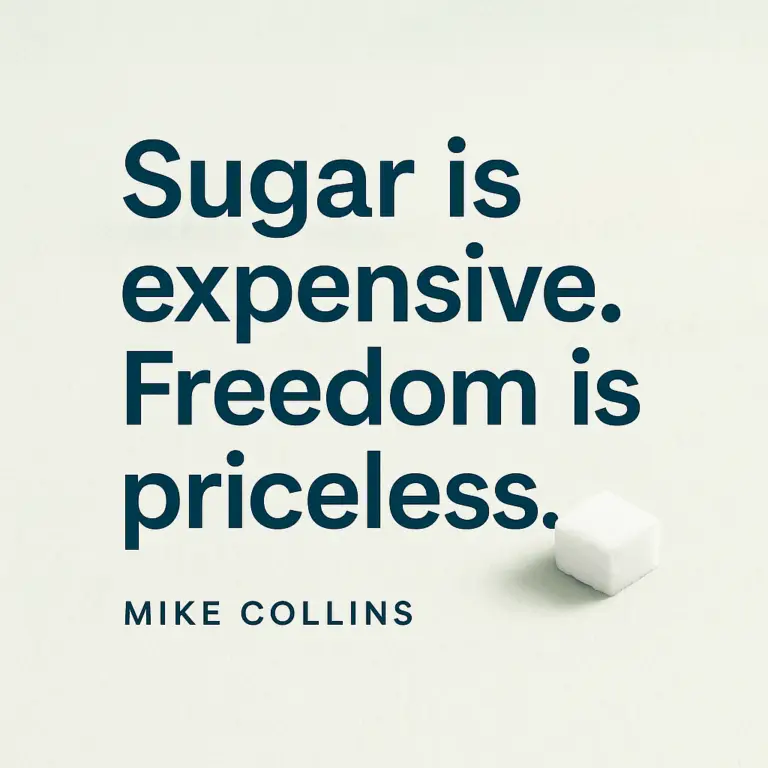
By Mike Collins, The SugarFreeMan
Founder of SugarDetox.com and the 30-Day Sugar Freedom Challenge
Quick Answer: Sugar Detox Timeline
A complete sugar detox takes approximately 30 days to experience freedom from cravings, with the most intense withdrawal symptoms lasting 3-7 days. However, full neurological and metabolic recovery can take 90 days or longer, depending on individual factors such as the duration of sugar consumption, overall health, and genetic predisposition.
Table of Contents
- What Happens During Sugar Detox
- Day-by-Day Sugar Detox Timeline
- Sugar Detox Symptoms by Phase
- Factors That Affect Detox Duration
- How to Speed Up Sugar Detox
- When to Seek Professional Help
- Frequently Asked Questions
If you’re wondering “how long does a sugar detox take,” you’re asking one of the most searched questions in nutrition – and unfortunately, mainly getting wrong answers.
As someone who’s been sugar-free for over 35 years and helped tens of thousands through the sugar detox process, I can tell you this: The real sugar detox timeline is longer and more complex than the 3-day cleanses and 7-day resets and the 10-Day Detox and the 21-Day Sugar Detoxes you’ve been sold.
But it’s also more rewarding than you can imagine.
This article was review by Dr. Camela McGrath, MD, FACOG. Find more about her here.
What Happens During a Sugar Detox

The Science Behind Sugar Addiction
Sugar affects your brain similarly to addictive substances, triggering dopamine release in the reward center. When you remove sugar, your brain experiences genuine withdrawal as it recalibrates its reward system.
Key biological changes during sugar detox:
- Neurotransmitter rebalancing: Dopamine and serotonin levels normalize
- Insulin sensitivity improvement: Your cells become more responsive to insulin
- Gut microbiome reset: Harmful bacteria that feed on sugar die off
- Hormonal regulation: Leptin (satiety hormone) and ghrelin (hunger hormone) rebalance
- Inflammatory reduction: Chronic inflammation from sugar consumption decreases
Why Most Sugar Detoxes Fail
Research shows that 97% of people who attempt short-term sugar detoxes return to previous consumption patterns within 30 days. This happens because:
- Insufficient duration: The brain needs at least 21-30 days to form new neural pathways
- Lack of support: Withdrawal symptoms are real and require proper management
- No behavioral change: Removing sugar without addressing underlying habits leads to relapse
Day-by-Day Sugar Detox Timeline
Phase 1: Days 1-3 (The Crash)
Duration: 72 hours
Intensity: Highest
Primary Challenge: Physical withdrawal symptoms
This is the most difficult phase of sugar detox. Your body is accustomed to regular dopamine hits from sugar, and when that supply stops, you experience genuine withdrawal.
Common symptoms:
- Intense sugar cravings (peak at 48-72 hours)
- Fatigue and low energy
- Headaches (affecting 87% of people)
- Irritability and mood swings
- Difficulty concentrating
- Muscle aches
- Nausea
What’s happening biologically: Your blood sugar is stabilizing, insulin levels are dropping, and your brain is desperately seeking its familiar dopamine source.
Success strategy: Focus on hydration, adequate sleep, and gentle movement. This phase will pass.
Phase 2: Days 4-7 (The Fog)
Duration: 4 days
Intensity: Moderate
Primary Challenge: Mental and emotional adjustment
You’re past the worst physical withdrawal, but your brain is still recalibrating.
Common experiences:
- Mental fog and difficulty concentrating
- Mild insomnia or sleep disruption
- Digestive changes (bloating, irregular bowel movements)
- Emotional volatility
- Reduced cravings but increased psychological desire for sugar
- You feel like you’re starving all the time (you’re not)
What’s happening biologically: Your gut microbiome is shifting as sugar-feeding bacteria die off. Neurotransmitters are beginning to rebalance.
Success strategy: Maintain consistent meal timing and include protein and healthy fats with every meal to stabilize blood sugar
Phase 3: Days 8-14 (The Shift)
Duration: 7 days
Intensity: Mild to moderate
Primary Challenge: Staying consistent as symptoms improve
Real healing begins during this phase. Your body starts to remember what normal feels like.
Positive changes:
- Clearer thinking and improved focus
- Better sleep quality
- More stable moods
- Reduced bloating and improved digestion
- Increased energy (especially morning energy)
- Skin improvements
What’s happening biologically: Insulin sensitivity is improving, inflammation is decreasing, and your gut microbiome is rebalancing toward beneficial bacteria.
Success strategy: This is when many people feel so good they’re tempted to “reward” themselves with sugar. Stay focused on the bigger picture.
Phase 4: Days 15-21 (The Craving Break)
Duration: 7 days
Intensity: Mild
Primary Challenge: Overconfidence leading to slip-ups
Your body has been without sugar long enough to stop desperately craving it. The emotional attachment to sugar significantly weakens.
What you’ll notice:
- Dramatically reduced cravings
- Easier meal planning and eating
- Sustained energy throughout the day
- Improved mood stability
- Better stress management
- Increased confidence and sense of control
What’s happening biologically: New neural pathways are forming, and your brain’s reward system is adapting to find pleasure in healthier foods and activities.
Success strategy: Document how you feel during this phase. You’ll need these reminders later.
Phase 5: Days 22-30 (The Freedom Zone)
Duration: 9 days
Intensity: Minimal
Primary Challenge: Maintaining habits long-term
You’re no longer just avoiding sugar-you’re actively choosing something better. This is where transformation becomes a lifestyle.
The freedom experience:
- Sugar cravings are rare and manageable
- Natural appetite regulation returns
- Sustained energy without crashes
- Improved physical performance
- Better emotional regulation
- Genuine taste preference changes
What’s happening biologically: Your reward system has largely reset, insulin sensitivity is significantly improved, and your gut microbiome has stabilized with beneficial bacteria
Sugar Detox Symptoms by Phase
Physical Symptoms Timeline
Emotional and Mental Symptoms
Week 1: Irritability, anxiety, depression, brain fog
Week 2: Mood swings, difficulty concentrating, emotional volatility
Week 3: Improved mood, clearer thinking, increased motivation
Week 4: Emotional stability, enhanced focus, greater confidence
Factors That Affect Detox Duration
Individual Variables
Your sugar detox timeline depends on:
- Duration of sugar consumption: Longer addiction = longer recovery
- Daily sugar intake: Higher consumption = more intense withdrawal
- Age: Younger people often recover faster
- Overall health: Better baseline health = quicker adaptation
- Genetics: Some people have genetic variations affecting sugar metabolism
- Stress levels: High stress can prolong withdrawal symptoms
- Sleep quality: Poor sleep extends recovery time
- Support system: Social support significantly impacts success rates
Types of Sugar Consumed
Different sugars affect detox differently:
- Refined sugar: Most addictive, longest withdrawal
- High fructose corn syrup: Similar to refined sugar
- Natural sugars (fruit): Gentler withdrawal when eliminated
- Artificial sweeteners: May prolong cravings by maintaining sweet taste preferences
How to Speed Up a Sugar Detox

Evidence-Based Strategies
1. Optimize Your Nutrition
- Eat protein with every meal to stabilize blood sugar
- Include healthy fats to promote satiety
- Choose complex carbohydrates for sustained energy
- Stay hydrated (aim for half your body weight in ounces daily)
2. Support Your Body’s Natural Detox
- Get 7-9 hours of quality sleep
- Exercise regularly (even light walking helps)
- Practice stress management techniques
- Consider supplements: chromium, magnesium, B-vitamins
3. Address Root Causes
- Identify emotional triggers for sugar consumption
- Develop alternative coping strategies
- Create a supportive environment
- Build new habits to replace sugar-dependent routines
4. Professional Support
- Work with a nutritionist familiar with sugar addiction
- Consider therapy for emotional eating patterns
- Join a support group or structured program
When to Seek Professional Help
Contact a healthcare provider if you experience:
- Severe depression or anxiety during detox
- Extreme fatigue lasting beyond 7 days
- Persistent insomnia
- Significant mood changes affecting daily life
- Any concerning physical symptoms
Consider professional support if:
- You’ve tried multiple times unsuccessfully
- You have underlying health conditions
- You’re taking medications that affect blood sugar
- You have a history of eating disorders
Frequently Asked Questions
How long does it take to stop craving sugar?
Most people experience a significant reduction in sugar cravings by day 15-21, with intense cravings typically subsiding by day 7. However, psychological cravings may persist longer and require behavioral intervention.
Can I speed up the sugar detox process?
While you can’t skip the biological timeline, you can minimize symptoms through proper nutrition, hydration, sleep, and stress management. The process typically takes 21-30 days regardless of interventions.
What’s the difference between a 3-day and 30-day sugar detox?
A 3-day detox only addresses initial withdrawal symptoms without allowing time for neurological adaptation or habit formation. A 30-day detox allows for a complete biological reset and sustainable behavior change.
Will I ever stop wanting sugar?
Yes, but it’s a process. Most people find that intense cravings disappear by day 21, and psychological desire for sugar significantly diminishes by day 30. After 90 days, most people report that sugar no longer holds the same appeal.
Is it normal to feel worse before feeling better?
Absolutely. Days 1-7 often involve feeling worse than when you started. This is your body’s natural response to removing an addictive substance and is a sign that the detox is working.
Can I have fruit during sugar detox?
This depends on your approach. Some people benefit from eliminating all sugars initially, while others find that including small amounts of whole fruit helps prevent intense cravings.
What if I slip up during the detox process?
One slip-up doesn’t restart your timeline completely, but it may extend the process. The key is to get back on track immediately rather than abandoning the effort entirely.
The Bottom Line: Your Sugar Detox Timeline
The real answer to “how long does a sugar detox take?” is:
- 3-7 days: To get through physical withdrawal
- 21-30 days: To break the psychological addiction and feel freedom
- 90 days: To establish new neural pathways and make changes permanent
- Lifetime: To maintain your sugar-free lifestyle
But here’s what matters most: You don’t need to think about forever. You just need to start with Day 1.
The journey from sugar addiction to freedom isn’t just about removing something from your diet-it’s about reclaiming your health, energy, and power over food choices.
Ready to Begin Your Sugar Detox Journey?
After helping tens of thousands of people through this process, I’ve learned that success comes from having the right support, structure, and day-by-day guidance.
That’s why I created the 30-Day Sugar Freedom Challenge – a complete system that walks you through every phase of the detox timeline with:
- Daily meal plans and recipes
- Craving management strategies
- Support community
- Expert guidance through each phase
- Tools to make the changes perm
Your future self – the one who walks past the candy aisle without a second thought – is waiting for you to take the first step.
About the Author: Mike Collins, known as “The SugarFreeMan,” has been sugar-free for over 35 years and is the founder of SugarDetox.com. He has helped tens of thousands of people break free from sugar addiction through his evidence-based approach combining nutritional science with practical behavior change strategies.
Medical Disclaimer: This article is for educational purposes only and is not intended to replace professional medical advice. Always consult with a healthcare provider before making significant dietary changes, especially if you have underlying health conditions.






